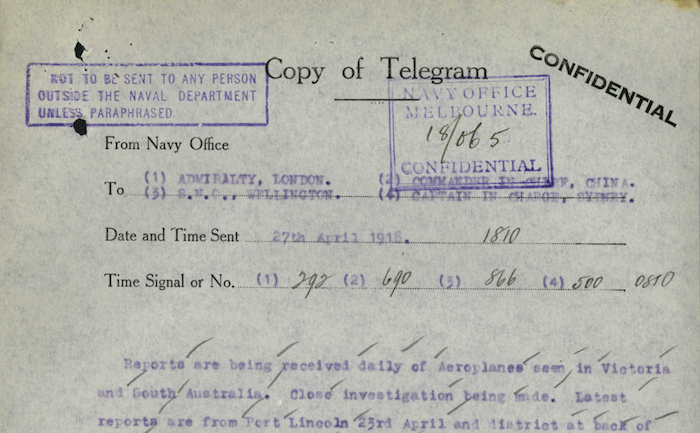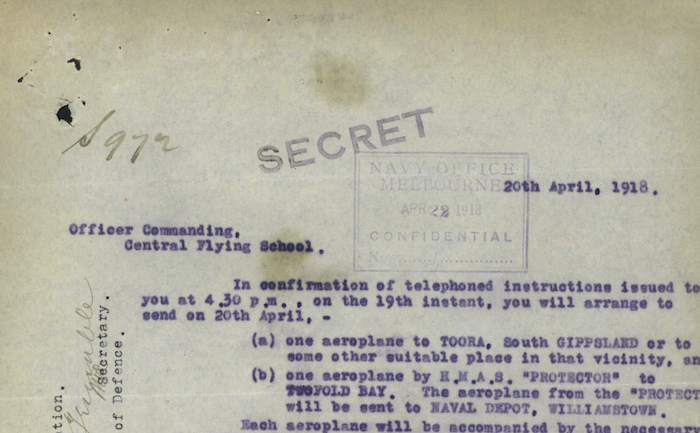
NAA: MP1049/1, 1918/066, page 459 is a copy of a telegram sent from the Navy Office to the Admiralty, London; Commander in Chief, China; Senior Naval Officer, Wellington; and Captain in Charge, Sydney. It reads:
Reports are being received daily of Aeroplanes seen in Victoria and South Australia. Close investigations being made. Latest reports are from Port Lincoln 23rd April and district at back of Cape Nelson. King Island indicated as a possible base. Rockets and other
suspicioussignals seen. Two and sometimes three aeroplanes sighted at same time. Australian aeroplanes are scouting at Corner Inlet and from BEGA about 50 miles north of GABO. No ships overdue or other indications of a raider. Aeroplanes may be in connection with some inland organisation.
"BRISBANE" ordered to Bass Straits [sic].
This is big. This is the Royal Australian Navy telling the Royal Navy: look, just FYI, we're not completely sure what's going on yet, and nothing has actually happened, but it looks like we might have a problem here. There are all these aeroplanes being reported from Victoria and South Australia, which could be from a raider, or perhaps more likely, might be evidence of an 'inland organisation' or 'a possible base' on King Island, between Tasmania and Victoria. We are looking into it with our own aircraft, and we're sending our best available ship, HMAS Brisbane, to the area...
Of course, it was the Navy's responsibility to keep the mother service informed of local matters, but equally there would have been a reluctance to cry Wolf redux unless there was a fairly strong suspicion that something might be up. Other British naval commands in the Pacific would need to be told, which is presumably why the China squadron and Wellington were notified directly (though the latter had no ships at its disposal); and the Admiralty might have passed this information on to the Imperial Japanese Navy and the United States Navy, too. So then it would become a big thing, and given that there was a risk of being wrong (as was in fact the case) and then looking foolish, the balance of probabilities had to outweigh that chance.
What I don't know, but would love to find out, is what the Admiralty did make of this. Did they think: oh no, here we go again? Did they put it down to overactive colonial imaginations? Did they just tell the Australians to carry on while they attended to the important business of warfighting? There's no record of a response in NAA: MP1049/1, 1918/066, but it could well exist in some other, probably more general file, or else in the National Archives in London. If I ever publish again on this topic it's something I should try to track down.
The other interesting (though completely irrelevant) thing about this document is all the check marks after each word, which I assume is the telegraphist checking their copy for transmission against the handwritten original. I'm not sure what the 'Time signal or no. [number]' means. I know that time signals could be sent over telegraph wires, and the four numbers would seem to correlate with the four receiving stations, but other than some sort of synchronisation or reception check, I can't guess what 292, 690, 866, 500 mean.
![]() This work is licensed under a Creative Commons Attribution-NonCommercial-NoDerivatives 4.0 International License.
Permissions beyond the scope of this license may be available at http://airminded.org/copyright/.
This work is licensed under a Creative Commons Attribution-NonCommercial-NoDerivatives 4.0 International License.
Permissions beyond the scope of this license may be available at http://airminded.org/copyright/.




